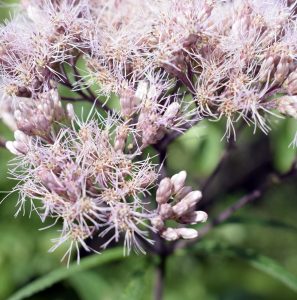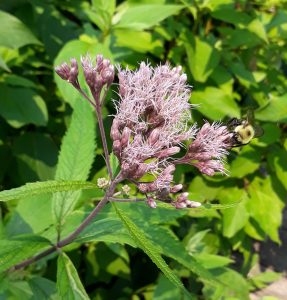Spotted Joe-pye Weed


 Eutrochium maculatum is a great summer pollinator plant. In my garden it is done blooming by late August, but in the greater MN region blooms depending on location July through September. with buds opening into fuzzy fireworks of furry stars swizzling purple petal-hairs outward en masse. The leaves grow concentrically in groups of 3-6 up a central deep, port wine red stem — quite striking. When I first came across this majestic plant growing along the riverbank I thought it was a species of milkweed. But upon closer observation, the flowers and leaves are completely different. In the back of a woodland garden this giant would shine! The sweet, abundant nectar attracts multitudes of bees and butterflies (see photo!). The other species in this genus that grows in Minnesota (and blooms a bit later, early August through September) is sweet scented Joe-pye weed (Eutrochium purpureum), with a lighter, lavender colored flower.
Eutrochium maculatum is a great summer pollinator plant. In my garden it is done blooming by late August, but in the greater MN region blooms depending on location July through September. with buds opening into fuzzy fireworks of furry stars swizzling purple petal-hairs outward en masse. The leaves grow concentrically in groups of 3-6 up a central deep, port wine red stem — quite striking. When I first came across this majestic plant growing along the riverbank I thought it was a species of milkweed. But upon closer observation, the flowers and leaves are completely different. In the back of a woodland garden this giant would shine! The sweet, abundant nectar attracts multitudes of bees and butterflies (see photo!). The other species in this genus that grows in Minnesota (and blooms a bit later, early August through September) is sweet scented Joe-pye weed (Eutrochium purpureum), with a lighter, lavender colored flower.
Joe-pye weed not only has an interesting name history, it also recently got removed from the genus Eupatorium (boneset plants) and is now reclassified into the genus Eutrochium. While still in the Aster family, the split occurred mainly to distinguish the purple-toned Joe-pye weed plants with their whorled leaves from the boneset plants with their alternative leaf arrangement and white flowers.
Various plants within this genus went by plenty of other common names before ‘white men’ came along, often having to do with the powerful healing properties of these plants which were well-known and used medicinally by indigenous Tribal Nations for centuries. The roots and flowers were used to treat urinary tract infections, gall stones, as a sweat inducing diuretic, a wash for gout and rheumatism, and so on. Spotted Joe-pye weed (E. maculatum) root was useful also in the treatment of inflammation of the joints. In 1818, botanist Amos Eaton, a 1799 graduate of Williams College, who lived and worked in Western Massachusetts published a Manual of Botany listing the common name of Eupatorium purpureum, (note the old Eupatorium designation) for the first time as “purple thoroughwort, or joe-pye“. In the 3rd edition, Eaton added a footnote for E. purpureum and E. verticillatum stating that “the two species, called joe-pye, (from the name of an Indian) are in common use in the western counties of Massachusetts as diaphoretics &c. in typhus fever.“.
So, there you have it. Joe-pye weed was named after man who did actually live in western Massachusetts, who was born in Connecticut in 1722 into the Mohican nation. Joseph Shauquethqueat, known to his white neighbors as Joe Pye, almost certainly shared knowledge of the healing properties of a plant that helped his white settler neighbors deal with a deadly disease sweeping through the region. Beyond having a flower named after him, Joe was a sachem (chief) and holds a definite place in American history as a leader of his people through the tumultuous political and social times of the era.
